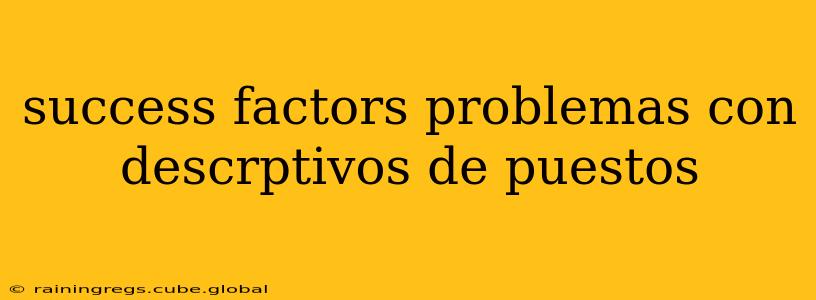Success Factors: Tackling the Challenges of Job Description Writing
Crafting effective job descriptions is crucial for attracting top talent and building a strong, productive workforce. However, many organizations struggle to write descriptions that accurately reflect the role and attract the right candidates. This article explores common problems encountered when writing job descriptions and offers practical solutions to improve the process, ultimately leading to greater recruitment success.
What are the common problems with job descriptions?
This is a fundamental question, and the answer is multifaceted. Many job descriptions suffer from a range of issues, including:
- Lack of clarity and conciseness: Vague language, overly long paragraphs, and jargon make it difficult for candidates to understand the role's requirements and responsibilities.
- Inaccurate or unrealistic expectations: Job descriptions that oversell the position or exaggerate the responsibilities can lead to mismatched hires and high turnover.
- Focus on tasks rather than outcomes: Listing individual tasks without highlighting the overall goals and impact of the role fails to inspire potential candidates.
- Bias and discrimination: Unintentional bias in language can deter qualified candidates from applying. This includes gendered language, assumptions about experience, and overly specific requirements that might exclude certain demographics.
- Failure to highlight company culture and values: Job descriptions that fail to reflect the company's culture and values can make it difficult to attract candidates who are a good fit for the organization.
- Outdated or irrelevant information: Job descriptions that haven't been updated in a while may not accurately reflect the current needs of the role or the company.
- Lack of compelling language: A bland, uninspired job description will not attract top talent. It needs to be engaging and exciting, highlighting the opportunities and challenges of the role.
How can I write a more effective job description?
Addressing these challenges requires a proactive approach to job description writing. Here's a step-by-step process:
-
Clearly define the role's purpose and objectives: Start by outlining the key responsibilities and the overall impact the role will have on the organization. What are the key performance indicators (KPIs) for success in this position?
-
Use concise and specific language: Avoid jargon and use clear, straightforward language that is easy for everyone to understand. Keep sentences and paragraphs short and to the point.
-
Focus on skills and experience rather than specific tasks: Instead of listing individual tasks, focus on the skills and experience required to successfully perform the role. This makes the description more flexible and allows for a wider range of candidates to apply.
-
Highlight the benefits and opportunities: Don't just focus on the responsibilities; also highlight the benefits of the job, such as career growth opportunities, competitive salary and benefits, and a positive work environment.
-
Review and revise your job description: Before posting the job description, have multiple people review it to ensure it is clear, accurate, and free from bias.
-
Use data and analytics to measure effectiveness: Track key metrics such as time-to-hire, cost-per-hire, and candidate quality to evaluate the effectiveness of your job descriptions and refine your approach over time.
What are some examples of successful job descriptions?
Successful job descriptions aren't generic templates; they are tailored to the specific role and the company's culture. However, they commonly share these characteristics: They clearly articulate the purpose of the role, highlighting its impact and contribution to the organization's goals. They use action verbs to describe responsibilities and focus on the skills and experiences needed for success. They emphasize the company culture and values, attracting candidates who align with the organization's mission. Finally, they are concise, easy to understand, and engaging, motivating top talent to apply.
By carefully addressing these key areas and implementing the suggestions outlined above, organizations can significantly improve the effectiveness of their job descriptions, leading to a more efficient and successful recruitment process. This ultimately translates to attracting and retaining high-quality employees, a crucial factor for any organization's success.
